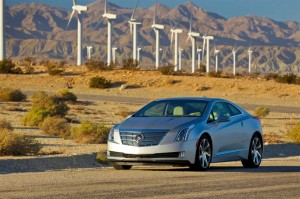
Cadillac's ELR allows a driver to send more energy back to the battery with the tap of a paddle shifter.
Paddle shifters have become increasingly commonplace in recent years, a way for motorists to get a more sporty feel from vehicles equipped with an automatic gearbox – but Cadillac has taken an alternative approach with its new ELR plug-in hybrid which uses its paddle shifters to increase the amount of energy that can be regenerated and stored in its battery pack.
Dubbed Regen on Demand, the new system was honored as “Green Car Technology of the Year” during a ceremony at the 2014 Washington Auto Show, beating out nine other environmentally friendly technology including a new Audi turbodiesel, a super-light carbon fiber body from BMW and Hyundai’s new hydrogen fuel-cell system.
“Ever-increasing efficiency is crucial to our driving future,” said Ron Cogan, publisher of the magazine Green Car Journal, which organizes the annual award, who called the Cadillac Regen on Demand technology, “an intriguing feature that adds a new dimension to the driving experience.”
A key to their efficiency, regenerative braking is used on all hybrids, plug-ins and battery-electric vehicles, recapturing energy normally lost during braking or coasting. What’s unusual about the system on the Cadillac ELR is that drivers can depress the paddles on the steering wheel to increase the amount of regen when they want to slow down more quickly. It’s similar to what happens when a motorist downshifts a conventional transmission – except that it has the added benefit of sending even more energy back to the battery.
“It provides a more engaged, satisfying driving experience,” Chris Thomason, chief engineer on the ELR program explained. “When you consider the added benefit of recapturing energy, it’s also a smart thing to do.”
(Click Here to read TheDetroitBureau.com’s review of the new Cadillac ELR.)
The ELR is an upscale version of the more mainstream Chevrolet Volt. It not only offers a more lavishly equipped cabin but improved performance, as well, launching from 0 to 60 in as little as 9 seconds, about a second faster than the Chevy plug-in. Yet the ELR maintains roughly the same battery range, 35 miles per charge, before its small internal combustion engine kicks in. The Regen on Demand system helps the Caddy achieve an EPA rated 90 MPGe, or miles per gallon-equivalent.
Green Car Journal offers two different annual awards. The new Honda Accord Hybrid was named “Green Car of the Year” at the Los Angeles Auto Show last November. The Green Car Technology award focuses on all-new technologies that can improve fuel efficiency, reduce emissions or in some other way make vehicles more environmentally friendly.
(Sales of plug-based vehicles doubled in 2013. Click Here for more.)
A total of ten different systems were finalists for this year’s award, including:
- Acura’s new Sport Hybrid SH-AWD powertrain which uses three motors to improve performance and handling as well as fuel economy;
- Ford’s 1.0-liter EcoBoost engine, a turbocharged 3-cylinder design that delivers small motor mileage and the power of a bigger engine;
- Audi’s 3.0-liter turbodiesel, which proves that these high-mileage “oil burners” can be quick, smooth and clean;
- The 3.0-liter EcoDiesel in the big Ram 1500 pickup from Chrysler;
- Mazda’s unique i-ELOOP regenerative braking system which uses an ultracapacitor, rather than a battery, to recapture energy;
- BMW’s super-light carbon fiber body shell on its new i3 battery-electric vehicle;
- The drivetrain on the plug-in hybrid version of the Honda Accord; and
- Hyundai’s hydrogen fuel-cell system which will go into production on a special version of the Tucson crossover vehicle later this year.
(Nissan becomes first automaker to ever sell 100,000 battery vehicles. Click Here for the full story.)
Launched in 2013, the first Green Car Technology of the Year award went to Mazda’s light and fuel-efficient SkyActiv system.
The use of the Washington Auto Show to hand out the award seems appropriate considering about a third of the vehicles on display this year utilize battery, clean diesel, hydrogen or other more environmentally friendly powertrain technologies.
